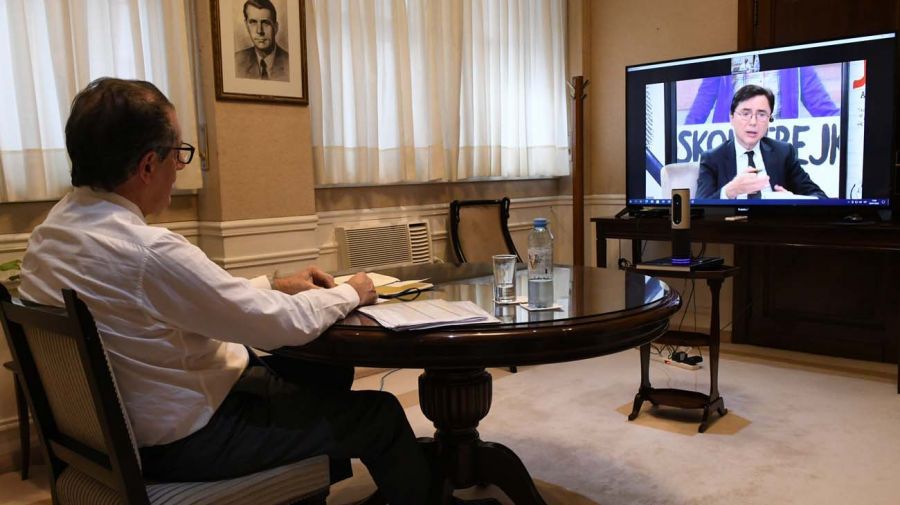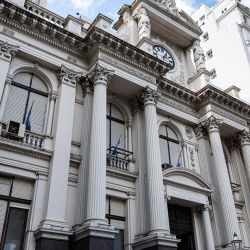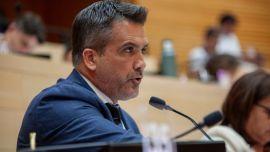Central Bank governor Miguel Ángel Pesce, as well as being an economic confidant, is also a long-standing friend of President Alberto Fernández.
Hours after the announcement of a preliminary agreement with the International Monetary Fund, the 59-year-old offered his view and discussed its economic and political consequences.
The dollar, the Central Bank reserves, inflation, public spending, money supply and even fintechs were on the agenda, in addition to electoral possibilities with successful implementation and five percent growth in the next two years.
Are you happy with the IMF agreement?
Yes, I’m happy but now our goal is not reaching an agreement with the IMF but sustainable growth for Argentina with less poverty and more jobs. That’s what would make us really happy. This agreement contributes because it reduces uncertainty and I think that’s a great step.
One commentary has it that Ilan Goldfajn, the former Brazilian Central Bank governor who is the new Western hemisphere helmsman for the IMF and reportedly a hardliner, said: “OK, if you don’t want labour reform, don’t bother and if you don’t want pension reform, don’t bother (both reforms carried out in Brazil while he was running the Central Bank), do what you like but then find your own funding by yourselves.”
Well, I’m not aware of Ilan having said that. I held a virtual meeting with him and he did not express himself that way, nor do I know what makes him tick within the IMF. What is true is that this agreement contains nothing on labour reform while pensions will continue to be updated according to Argentine law without any request for modification. In that sense, no adjustment was requested for either social or capital spending – on the contrary, something like 60 percent real growth is scheduled for the latter according to the agreement.
When Argentina was given US$44 billion, that was something totally unusual in IMF history. Is this agreement also unusual?
Even if I haven’t studied all the IMF’s extended fund facilities agreements in depth, this one beyond any doubt meets the requirements of our country for sustained economic growth towards the ends of reducing poverty and creating jobs. I don’t know what the IMF’s motivations were or what has changed in the Fund since the 1980s and the 1990s. Today we are applying a time schedule similar to that of Iceland.
What are the similarities between Iceland and Argentina?
Well, as seen especially in the panel on the previous agreement, the stand-by which we are now replacing with extended fund facilities, capital controls have been established in this programme. It does not rely exclusively on price adjustments, a major devaluation or a steep rise in interest rates but uses regulatory mechanisms to avoid macroeconomic imbalances.
Just one or two weeks ago, all the talk was of no agreement. Did this agreement emerge at the last minute or was the previous information mistaken?
We’ve been working with the IMF for several months. Remember that mission in late 2020. I would say that we have been working with them every week for over a year, reviewing standpoints and questions relating to our balance of payments, our exchange rate and our monetary policy. Argentina is a complex country and as such has complex institutional and regulatory structures, which does not make it easy for somebody coming to Argentina to understand this regulatory framework. There has been some pretty intense work, as in every negotiation, and it gets harder towards the end because you have to end up adjusting the numbers and the Argentine government wanted to guarantee a programme with growth, like I said, and investment, without violent leaps in devaluations or interest rates. The frustration of the population with the macroeconomic lurches of 2018 and 2019 has been demonstrated.
When you say that there was a more rapid decision-making process towards the end, was that because there was a last-minute change in the IMF’s attitude?
Yes, without any doubt. The decision was hastened by the dateline. We needed to be sure that we were marching firmly towards an agreement with the IMF because that day [last Friday] we paid US$717 billion in capital to the IMF and next week we have a further US$250 million in interest rates lined up. So we wanted to be sure that we were marching firmly towards an agreement in order to be able to make those payments.
Did Argentina saying: “If we do not reach an agreement, we’re not paying” trigger the agreement?
I don’t think so. I don’t think you can hustle the IMF but undoubtedly the proximity of payment made it more possible for us to reach an agreement.
Was there a tug-of-war over what [Economy Minister Martín] Guzmán called the “narrow fiscal path”? A reduction of the primary fiscal deficit for 2022 by just over half a point of Gross Domestic Product seems easily attainable for Argentina.
It seems favourable beyond any doubt but I insist, it seems to me that the closing details, especially the possibility of more margin with the primary deficit and being able to sustain capital spending in real terms in the next few years, were arduously argued and could only be resolved in the past week.
Does this open up for Argentina a growth superior to forecasts, for example, five percent in the next two years?
Yes, I believe there is a floor of four percent for this year. Argentina’s growth rates are always surprising, such as last year when in September we were expecting growth of around seven percent and it ended up being 10 percent. It is very possible that Argentina’s growth rate this year will again surprise. The agreement with the IMF is key because it permits us to leap over the precipice which loomed for both this year and the next. It was absolutely impossible for Argentina with its level of exports and its capacity to generate balance of payments surpluses to be able to face the US$18-19 billion falling due this year and next. This agreement leapfrogs both those precipices. Now we have to continue boosting what I have insisted on with every interview I’ve had with you – the importance of increasing exports. Last year we exported practically US$78 billion, coming from export levels of around US$64 billion. It is very difficult to sustain that dynamism over the years but if Argentina tops US$80 billion this year, I believe that will open up a very important growth path. The credit for achieving greater responsibility in the design of this agreement should not go to the IMF but to the Argentine authorities. And I agree with what you say, that’s a path we could follow without any doubt. If not, we wouldn’t have signed this agreement.
The catastrophic discourse came more from the libertarians and the so-called ‘PRO hawks.’ Does this agreement banish the catastrophic scenario which would have given better electoral chances to the sectors closest to the libertarians and hawks? And on the reverse side, does it give Alberto Fernández and the Cambiemos moderates the chance to be more competitive in next year’s elections?
Those are political considerations. I like politics but the answer to your question is complex. What I do think is that this permits us to follow an economic growth path for the next two years. That is not all within the agreement, I insist, we need to export more. We need to broaden production so that when there are demand pressures, supply does not respond with [higher] prices but with increased production. And without doubt such a growth path will give us more jobs with real wages on the rise, as happened last year. Well, that response has to translate into electoral results.
You’ve known Alberto Fernández for many years as his friend and confidant. How did you see him these last few days? Empowered as after the November midterms?
I saw him very worried and I was not with him yesterday [January 28]. We had some meetings planned by him in the previous days and I saw him as truly very worried, both by the need to guarantee that the agreement permitted Argentina to grow and by the consequences which the new agreement with the IMF might bring. I would imagine him as happy after reaching agreement with the Fund.

What will Alberto be doing in China financially? Will be bring back a currency swap or a bridging loan from there?
China is a very important trade partner for Argentina. Last year we imported US$13 billion from China with a trade gap of over US$7 billion. A key element in our relationship with China is the currency swap between the People’s Bank of China and our Central Bank. Argentina pushed from the start the possibility of the yuan incorporating the IMF’s currency shopping-basket. We’ve worked towards that. That’s why we signed the first swap of US$10 billion, which is now US$20 billion. The idea is that we can use the swap to sustain Argentina’s growth and somehow work towards our trade imbalance with China finding an answer via such financing. That’s what we have been permanently working for with our Chinese banking colleagues. In the presidential visit it is impossible for such an important instrument not to be present in some conversation. A while ago China took an important step when it picked ICBC, a bank represented here in Argentina, to develop the play in-house of yuans in our country. We approved that here in my previous Central Bank term and we have taken a fresh step in this direction. I recently permitted banks to have yuan accounts in the Central Bank and also for ICBC to have local usufructuary rights for their companies, thus strengthening the yuan as a global currency. All this context has to do with the swap agreement which we have with China.
It has been said that the extraordinary credit granted by the IMF, remitting all the money at once and not in tranches as usual, was the result of the special relationship which Donald Trump had with ex-president Mauricio Macri. Another perspective is that the United States simply forced the Fund to grant that special credit to offer an exit for the US funds trapped in Argentina. Indeed, Macri said in an interview that the IMF money was to pay off the banks. What happened to those who stayed?
Those who stayed were fundamentally those who had bought peso bonds under Argentine law because those who had bought dollar bonds under foreign law entered into the process of the 2020 debt swap. There was then no debt swap for bonds under Argentine law so that those assets remained within our own market, which is a novel situation. We have always spoken of the need for care with speculative investments in the capital markets of our country, due to the strategy of the previous government and the strategy of the funds themselves staying with these bonds in their portfolio and [without any offer of a swap] trying to dump them via the bond market.
Is it plausible that there was US pressure on the Fund to lend to Argentina so that their investors could get those dollars out?
They got out but fundamentally for the expiry dates which the foreign funds had and also for the process of dollarisation in our country in 2018 and 2019 when there was a capital flight of US$23 billion. A record was set in 2018 and it reached US$19 billion in 2019 only because exchange restrictions were established in September, otherwise it would surely have topped US$23 billion. The debts run up by Macri’s government are not to be seen in public works or infrastructure or social development – they served to permit the exit of those foreign investors who had entered in the early years of 2016 and 2017, as well as to permit the speculative manoeuvres of Argentine residents
Was it mostly US capital or managed from that country?
They’re funds, many of them based in tax havens. The truth is that I do not have them identified. These investment funds might very possibly be US-managed but do not necessarily have their legal address in the United States.
What is the impact of the agreement on the strength of reserves? Where are they today and how do you imagine their future evolution?
We were at around US$38 billion in reserves. As the minister has also explained, what we are now awaiting is an important reimbursement at the start of the programme to cover the 2022 deadlines.
Besides US$2 billion.
All this year’s deadlines or a substantial part of them, plus the US$4.3 billion of special drawing rights from the IMF which we paid last September and December. We have now paid the US$717 million on the deadline and in March we have a payment of around US$3 billion. I think that the agreement will be sealed before the payment falls due when we will receive a reimbursement which will substantially cover this year’s commitments plus the payments already made to the IMF.
How do you imagine reserves by the end of the year?
We’re working towards increasing reserves, that’s one point in our discussion with the IMF. That does not only depend on our exchange market surplus but also on the IMF contribution to be made. Just think that within a month we will have to pay US$1.5 billion in interest but we’re going to receive this reimbursement of around US$4.3 billion, thus increasing reserves. We are also expecting an increase in reserves as the result of our dealings with the multilateral credit organisations, with whom we are working bilaterally and also in cooperation with the IMF so that we have a net positive result this year. But we are also expecting increased reserves for the close of the agreement when there is talk of around US$5 billion but that is something on which we are still working and fine-tuning the numbers which are still being discussed with the Fund.
Will those who bet on a dollar of 220 pesos finally end up losing money? Will the situation, not of last December but the end of 2020, be repeated?
Those types of phrases always lead to errors. I’m not going to make that kind of affirmation but we estimate that the Fund is indeed not requesting a major devaluation in the framework of the agreement. We agree that a competitive exchange rate is necessary but with no room for doubt 220 pesos does not tie in with the history of a middle-income country like Argentina.
How will the dollar evolve this year on the basis of the agreement with the IMF? What would you do to reduce the gap [between the official and parallel exchange rates]?
We believe that the gap will narrow. And I insist, those who make that kind of market bet should pay attention to signals like this agreement we have reached with the IMF. We have expressed a commitment since the start of our administration to avoid the exchange rate lagging behind. And we have continued along those lines and will continue to do so in this context. We do not believe in the prices set in those tiny markets – US$40-60 million a day as against up to a billion dollars in the official exchange market and the contado con liquidación [parallel but legal exchange rate]. So any bet made in such tiny markets triggers important exchange rate movements. The truth is that we have managed to sustain our exchange rate strategy throughout 2020 and 2021. In all those contexts we have sometimes needed regulatory tools but we have tried to make them affect productive processes in Argentina as little as possible. I believe we have achieved that because we have achieved very high levels of imports, record levels even, like I’ve already said, in intermediate inputs and Argentina could grow 10 percent last year.
Does the agreement with the IMF affect the independence of the Central Bank?
We’re not going to make any decision of which we are not convinced. And we have reached this agreement because we believe it to be satisfactory for our country.
Does the Economy Ministry interfere at all in the measures and policies of the Central Bank?
No, that’s forbidden by law.
If part of the agreement with the Fund is that the Central Bank progressively stops financing the Treasury, what must the state do with its primary and financial deficits?
We are expecting revenue to grow strongly with less monetary financing for the Treasury this year. The Treasury will have to finance itself from the multilateral credit organisation and capital markets, which will also contribute to reducing the Central Bank’s mass of Leliq bonds.
If the deficit is 2.5 percent of GDP the first year and 1.9 percent the second, adding those up makes 4.4 percent to be financed by new debt. Does progressively phasing out printing money indicate some degree of orthodoxy?
Well, orthodoxy did not achieve that. What happened is that the pandemic caught us in the middle of the road, forcing us into an extraordinary monetary output in 2020. And, it should be said, we had to decelerate that even within the context of pandemic – monetary financing was halved last year. The virtuous context for the Treasury would be financing itself with taxation and market placements. We need to aim towards that. The Fund has recognised that this is a gradual and non-violent process.
When you moved into the Central Bank (in 2019), the headline for our first interview was that you were expecting single-digit inflation for 2021. Obviously the pandemic came along in between and modified everything. When are you imagining single-digit inflation now?
Inflation is a complex and exuberant phenomenon also affected by external impulses which has not only accelerated in our country but absolutely worldwide with every country reporting unusual levels of inflation. We were expecting an important deceleration for this year. That last time you insisted on some forecast as to when there might possibly be single-digit inflation. And if there is one thing I don’t like, it is conjecture. We have a commitment to lowering inflation and we’re going to bring it down to lower levels, much lower than last year. But I’m not going to conjecture again.























Comments